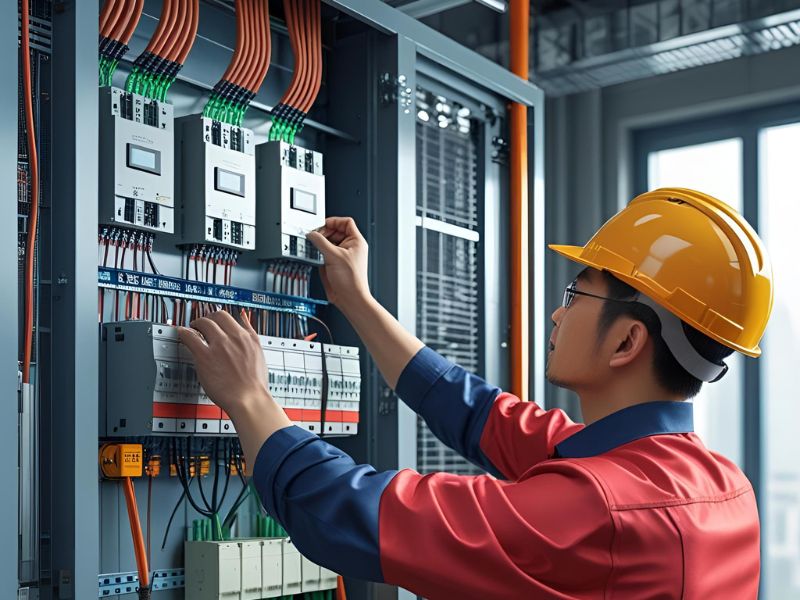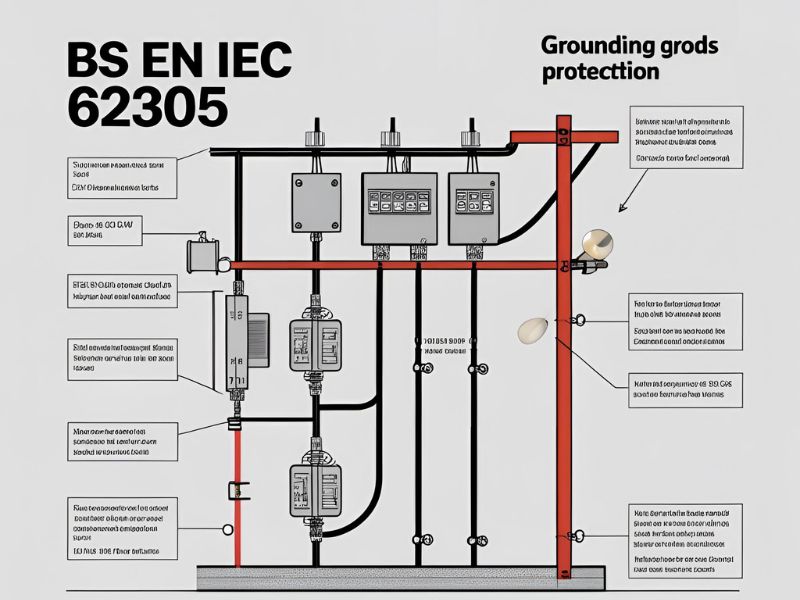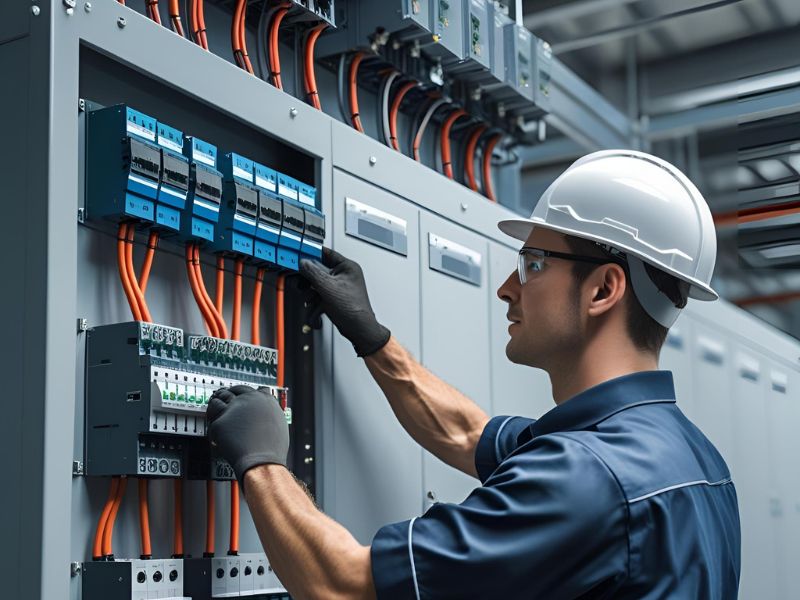
Here's something that confuses even seasoned professionals: you'll see both "BS EN 62305" and "BS EN IEC 62305" referenced in lightning protection documentation. Are they different standards? Does one supersede the other? And why should you care which one your system follows?
The answer affects more than just paperwork. We're talking about insurance validity, regulatory compliance, and whether your protection actually works when 200,000 amps of lightning current hits your building.
Let's clear this up once and for all.
BS EN IEC 62305 is not a different standard from BS EN 62305. It's the same protection system with explicit labeling that shows its international pedigree.
For those wondering what is BS EN 62305, it’s the core standard for lightning protection systems—used to safeguard structures, people, and electrical systems from lightning strikes.
Here's what happened: In 2022, BSI (British Standards Institution) began explicitly publishing "BS EN IEC" versions to clarify what we call "triple adoption." This means the standard meets UK requirements, European norms, and international benchmarks all at once.
The full naming looks like this: BS EN IEC 62305-1:2011
Breaking that down:
This isn't just academic labeling. It matters for real-world applications.

The International Electrotechnical Commission developed IEC 62305 to solve a massive problem: every country had different lightning protection approaches, and none of them talked to each other.
Before IEC 62305, a system designed in Germany might not meet requirements in the UK. Equipment certified in one country couldn't be trusted in another. The global economy needed a unified approach to lightning protection.
IEC 62305 became that unified approach. Today, over 50 countries use this standard as their foundation for lightning protection. When you specify BS EN IEC 62305, you're not just meeting UK requirements. You're using protection methods recognized worldwide.
While BS EN 62305 and BS EN IEC 62305 contain identical technical requirements, businesses in regulated industries increasingly specify the full "BS EN IEC" format.
Why? Because it demonstrates compliance with international standards, not just national minimums.
We see this especially in:
These sectors need to prove their protection meets global benchmarks. The "IEC" designation provides that proof.
Both BS EN 62305 and BS EN IEC 62305 use identical Lightning Protection Levels (LPL 1-4), but understanding these levels is crucial for proper protection.
LPL 1 handles the most severe lightning strikes, up to 200,000 amps of current. This level applies to facilities where lightning damage could cause explosions, environmental disasters, or loss of life.
LPL 4 provides protection for lower-risk buildings like standard residential structures or small commercial buildings.
The protection level you need depends on your risk assessment, which considers factors like building height, occupancy, local lightning density, and consequences of failure.

Here's where BS EN IEC 62305 shows its superiority over older standards like BS 6651. Part 4 of the standard covers Surge Protection Measures (SPMs) for internal electronic systems within structures.
For context, if you're asking what is the IEC standard for SPD, it’s IEC 61643—often referenced alongside BS EN IEC 62305 Part 4 when designing coordinated protection strategies.
BS 6651 focused mainly on protecting building structures. It barely addressed the electronic systems that now run everything from security to HVAC to manufacturing equipment.
BS EN IEC 62305 Part 4 uses a three-zone approach:
This systematic approach prevents the cascade failures that destroy entire electrical systems during lightning events.
Non-compliance with BS EN IEC 62305 standards creates serious financial and legal risks.
Insurance companies increasingly require compliance for coverage, especially for commercial and industrial properties. Lightning accounts for 10-15% of electrical surge-related insurance claims in the UK, and insurers want proof that your protection actually works.
But insurance is just the beginning. Failure to comply can lead to regulatory breaches under the Electricity at Work Regulations 1989. If someone gets injured or systems fail due to inadequate lightning protection, you face potential legal claims.
The "IEC" designation often carries more weight in legal proceedings because it demonstrates you followed internationally recognized best practices, not just minimum local requirements.
BS EN IEC 62305 Part 2 provides sophisticated risk management formulas that account for local conditions while maintaining global consistency.
The risk assessment considers:
This assessment determines whether you need lightning protection and what protection level is appropriate. It's not guesswork. It's mathematical analysis based on decades of lightning research.

The installation requirements in BS EN IEC 62305 reflect global best practices, not just UK preferences.
Air terminals must be positioned using the rolling sphere method, with sphere radii that vary by protection level. Down conductors follow specific routing rules to prevent dangerous side flashes. Earth termination systems must meet precise resistance values measured under standardized conditions.
These requirements exist because lightning behaves the same way everywhere. Physics doesn't change at national borders.
BS EN IEC 62305 specifies testing procedures that ensure your protection continues working over time.
Annual testing is recommended, with mandatory retesting after major building modifications or extreme weather events. The testing covers:
Each test has specific pass/fail criteria. There's no subjective judgment about whether your system "looks okay."
The complexity of BS EN IEC 62305 means professional installation isn't optional. The standard includes specific competency requirements for designers and installers.
Risk assessment calculations require specialized software and training. Installation demands precision that only comes with proper equipment and experience. Testing requires calibrated instruments and knowledge of acceptable values.
We regularly see systems that look correct but fail testing because installers didn't understand the standard's requirements. Lightning protection that fails when you need it most is worse than no protection at all.
The IEC regularly updates 62305 based on new research and technology developments. Discussions for the next major revision began after 2019, focusing on improved surge protection and updated risk factors.
When IEC changes are adopted, they flow through to European (EN) standards and then to British (BS) adoption. This process ensures UK protection stays current with global developments.
Using BS EN IEC 62305 means you're not just meeting today's requirements. You're positioned for future updates and improvements.
Businesses that follow BS EN IEC 62305 often see unexpected economic benefits beyond risk reduction.
International equipment suppliers prefer working with facilities that meet global standards. Insurance premiums may be lower when you can demonstrate international compliance. Export opportunities expand when your facilities meet standards recognized in target markets.
The cost difference between basic compliance and international standard compliance is minimal. The long-term benefits are substantial.

BS EN IEC 62305 includes provisions for protecting cultural heritage structures, industrial facilities with explosive atmospheres, and other special applications.
These requirements balance protection needs with preservation requirements or safety constraints. The international perspective ensures solutions work across different regulatory environments.
Whether you specify "BS EN 62305" or "BS EN IEC 62305" in your documentation, you're getting the same technical protection. But the full designation often provides advantages in regulated industries, international projects, or situations where you need to demonstrate compliance with global best practices.
The choice depends on your specific situation and requirements. Professional assessment can determine which designation best serves your needs.
BS EN IEC 62305 represents the current state of lightning protection science. It provides proven methods for protecting people, buildings, and equipment from lightning damage while meeting international standards.
But standards are only as good as their implementation. Proper risk assessment, professional installation, and ongoing maintenance ensure your protection works when lightning strikes.
Don't compromise on lightning protection. The consequences of inadequate protection far exceed the cost of doing it right.
Need lightning protection that meets BS EN IEC 62305 international standards? Contact Lightning Protection Testing UK for your free quote. We provide professional assessment, installation, and testing services that ensure your protection meets global best practices and keeps you safe when it matters most.